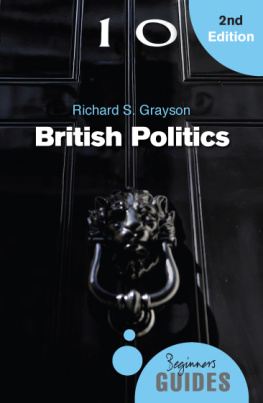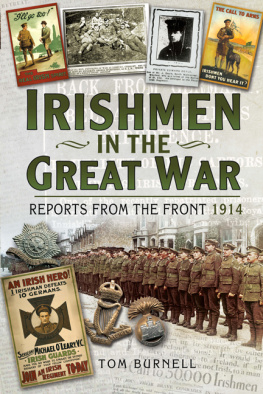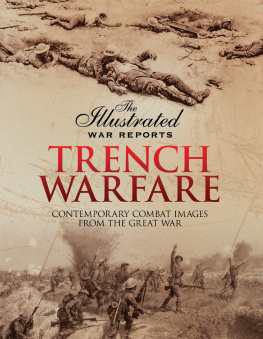Acknowledgements
I would like to thank Mrs Rosamund Du Cane, Max Staniforths daughter, for allowing me to edit her fathers letters, and for making me so welcome at her home. Her enthusiastic collaboration with the project from first to last has been invaluable and it has been a pleasure both meeting her and working with her.
I am very grateful to Terry Denman for his advice on a number of points regarding this project. All writers on the 16th (Irish) Division owe him a debt of gratitude for opening up the field with his work. His article on Staniforth was a valuable alert to the existence of letters which were not in Staniforths typescript.
Thanks are due to Judith Curthoys, the Archivist at Christ Church, for providing information on Staniforths degree, and to Jeremy Hargreaves, who kindly explained some Christ Church terminology.
At the Imperial War Museum, Elizabeth Bowers, Madeleine James and Anthony Richards have been very helpful throughout. I am especially grateful to Madeleine for arranging for photographs to be taken of various items held in the IWMs collection. I would particularly like to thank Amanda Mason for her helpful comments on a draft of this volume. Rod Suddaby provided useful information at a seminar on Staniforth held at the IWM in November 2011. Thanks are also due to Emily Fuggle for organising that seminar. The Reverend Clive Hughes, formerly of the IWM, collected the letters from Max Staniforth in 1981 and I am grateful to him for the time he took to discuss his recollections with me over the phone. I am also grateful to Barbara Levy, the IWMs literary agent, for arranging the contract with Pen & Sword, where thanks are also due to Rupert Harding for his guidance.
I continue to be grateful to Sen OHare, Harry Donaghy and all others involved in the 6th Connaught Rangers Research Project, for their inspirational enthusiasm for the memory of the 16th (Irish) Division. Thanks are due to Julian Putkowski for sharing with me his 2005 paper which, in the context of a wider discussion of the Second Battle of Ypres, addressed the phenomenon of Germans allegedly being found wearing British uniforms.
Permission to quote from the Staniforth letters and to reproduce images of them is provided by Mrs Rosamund Du Cane. The Imperial War Museum has provided permission to reproduce photographs from its collections. The 1982-3 pictures of Staniforth in his study are from Hampshire, The County Magazine and are reproduced by kind permission of Jon Benson of the Mark Allen Group.
Finally, I would like to thank my wife and son, Lucy and Edward, for tolerating the mental absences which such a project involves, and my Mum, Jannat, for supporting us all.
Appendix
Archives at the Imperial War Museum used for this book were as follows:
IWM Documents J.H.M. Staniforth, 67/41/1-3
IWM Documents J.F. Blake OSullivan, 77/167/1
IWM Documents W.A. Lyon, 80/25/1
Further reading
Good starting points for Ireland during the Great War are:
Dungan, Myles, Irish Voices from the Great War (Dublin, 1995).
Dungan, Myles, They Shall Grow Not Old: Irish Soldiers and the Great War (Dublin, 1997).
Gregory, Adrian and Paeta, Senia (eds), Ireland and the Great War: A War to Unite Us All? (Manchester, 2002).
Horne, John, ed., Our War: Ireland and the Great War (Dublin, 2008).
Jeffery, Keith, Ireland and the Great War (Cambridge, 2000).
Johnstone, Tom, Orange, Green and Khaki: The Story of the Irish Regiments in the Great War, 1914 18 (Dublin, 1992).
Terence Denman has written extensively on the 16th (Irish) Division:
The 10th (Irish) Division 1914 15: A Study in Military and Political Interaction, Irish Sword 17, 66 (1987), pp. 16 25.
An Irish Battalion at War: From the Letters of Captain J. H. M. Staniforth, 7th Leinsters 1914 18, Irish Sword , 17 (1989), pp. 165 217.
The Catholic Irish Soldier in the First World War: the Racial Environment, Irish Historical Studies , XXVII, 27. (1991), pp. 352 65.
Irelands Unknown Soldiers: The 16th (Irish) Division in the Great War (Dublin, 1992).
A Lonely Grave: The Life and Death of William Redmond (Blackrock, Co. Dublin, 1995).
The 16th (Irish) Division on 21 March 1918: Fight or Flight? Irish Sword , 69 (1999), pp. 273 87.
Other useful studies of specific units/battles/issues affecting Irish units on the Western Front are:
6th Connaught Rangers Research Project, The 6th Connaught Rangers: Belfast Nationalists and the Great War (Belfast, 2008, 2nd edition 2011).
Bowman, Timothy, Irish Regiments in the Great War: Discipline and Morale (Manchester, 2003).
Burke, Tom, The 16th (Irish) and 36th (Ulster) Divisions at the Battle of Wijtschate Messines Ridge, 7 June 1917 (Dublin, 2007).
Grayson, Richard S., Belfast Boys: How Unionists and Nationalists Fought and Died Together in the First World War (London, 2009).
Orr, Philip, The Road to the Somme: Men of the Ulster Division Tell their Story (Belfast, 1987).
Documents at The National Archives, Kew, are increasingly available to download online. Others are available for consultation by anybody with a readers ticket (see the Kew website for details on which personal documents should be shown to obtain one of these). The main items relevant to this study are:
| WO 158/416 | 16th Division, Narrative of Operations 7th to 9th June 1917 |
| WO 339/15145 | Capt. J.H.M. Staniforth |
| WO 339/23115 | Lieut J.H.M. Staniforth |
| WO 95/1955 & 1956 | 16th Division General Staff War Diary |
| WO 95/1969 | 47th Brigade HQ War Diary |
| WO 95/1969 | 6th Connaught Rangers War Diary |
| WO 95/1970 | 7th Leinsters War Diary |
| WO 95/2308 | 2nd Leinsters War Diary |
Notes
Editors Introduction
Staniforth was known in his family as Max, from his middle name, Maxwell. His fathers diary, held by his daughter, was begun in 1902 and refers to Staniforth as Max from that point. However, he signed all his letters to his parents during the war John and was called that by other officers. Not until March 1920 did Staniforth sign himself Max in letters to his parents.
The most positive response recited the current economic situation as a factor. A letter dated 1 October 1985 said, I am afraid only a limited number of people are buying books like this at the moment. Ironically, this was from Leo Cooper, whose imprint Pen and Sword agreed, a quarter of a century later, to publish the book.
The National Archives, Kew [TNA]: WO 339/15145, File on Capt J.H.M. Staniforth.
On this subject, see Thomas Hennessey, Dividing Ireland: World War I and Partition (London, 1998), pp. 80-124.
Richard S. Grayson, Belfast Boys: How Unionists and Nationalists Fought and Died Together in the First World War (London, 2009), p. 17
Irish News , 12 February 1915, p. 4.
The letters have the Imperial War Museum reference 67/41/1-3 and were deposited with the museum in March 1981 by Staniforth himself. In addition to those described for the May 1917 to March 1918 gap, there are also four from April, two from May and one from September 1918. One other letter is filed with that dated 8 September 1917 but its date is unclear.
See p.19.
A number of the authors editorial comments from his typescript are included in the notes (clearly labelled as being the authors).

















